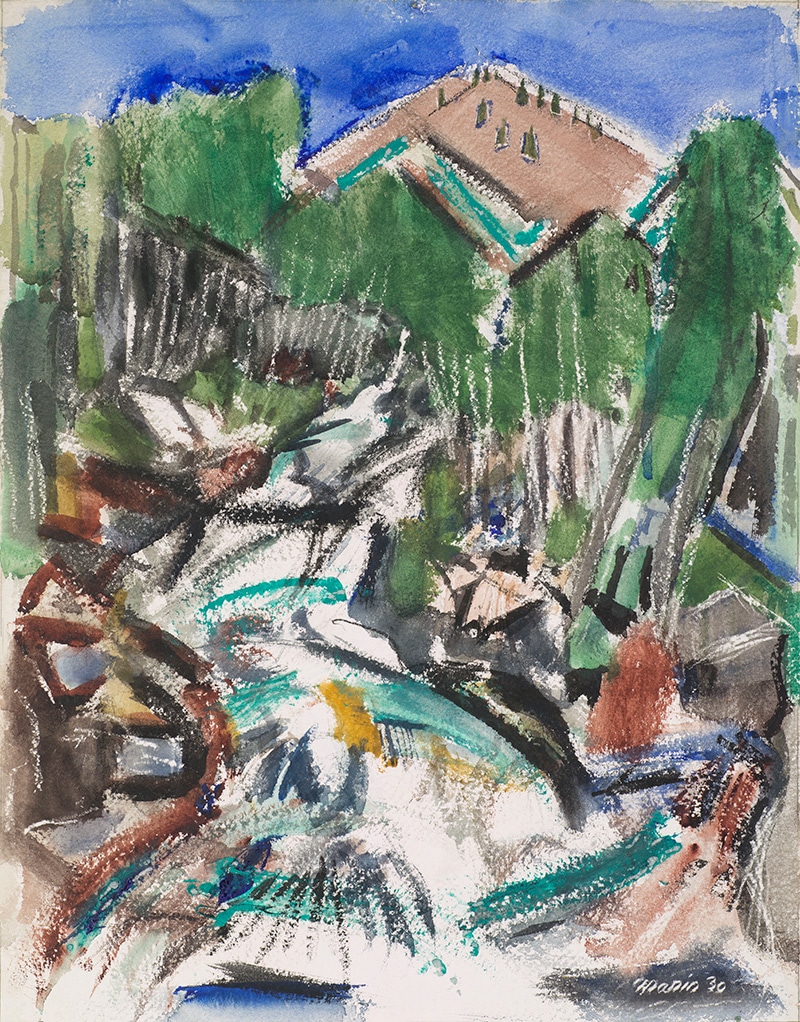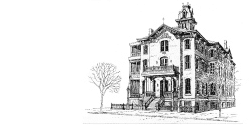Musicality through Abstraction
John Marin (1870-1953), Blue Sky, Mountain Aspens, and the Roaring Hondo, 1930.
Emil Bisttram, Syncopated Rhythm, No. 2, no date.
Background Information
America was first introduced to Modernism in a big international exhibition, the Armory Show, held in New York City in 1913. Challenging the notion that art must realistically depict the world, many artists experimented with the expressive use of color, non-traditional materials, and new techniques and mediums. Artists and the public were blown away by their first introduction to modern artistic styles, such as Impressionism, Expressionism, Cubism, Abstraction, Fauvism, Futurism, Dada, Surrealism, and Abstract Expressionism. Descriptions of these colorful and dynamic styles quickly spread to the West. As the West began to change after the turn of the 20thcentury, artists also changed the way they represented it and many chose to embrace modern styles.
Many modernist artists, including Emil Bisttram and John Marin, used music as inspiration to create abstract paintings. Artists listen to a range of musical styles for inspiration and enjoyment. Whether it’s a historic composition or a contemporary recording, music can provide harmony, color inspiration, and perspective. Just like in a ballet, music and art can tell a story.
Look Closer

Look carefully at the river and notice the different directions and styles of lines he used. Dry brush is used here
as well as wet,
and the dynamic between the two (differences in technique and paint application) is what adds the rough element to watercolor, which is oftentimes seen as a very smooth and precise medium
Look at the violent thrashing water in the foreground.
As you peer farther into the painting, the calmer the water appears, and likewise, the softer and more even Marin’s use of color and application of paint.
Marin has placed smooth paint next to roughly applied dry paint and used discordant colors like mustard yellow against a blue/green,
and patches of indigo next to umber to cause friction and echo the energy of the rushing water.
Additionally, Marin has drawn attention to negative space by leaving untouched watercolor paper next to the bright colors of paint as seen here.
Additionally, Marin has drawn attention to negative space by leaving untouched watercolor paper next to the bright colors of paint as seen here.
Additionally, Marin has drawn attention to negative space by leaving untouched watercolor paper next to the bright colors of paint as seen here.
John Marin (1870-1953), Blue Sky, Mountain Aspens, and the Roaring Hondo, 1930.
John Marin was a modernist who incorporated elements of Cubism, Futurism, Fauvism, Abstraction, and Impressionism in his composition. He is credited as a precursor to the modernist style Abstract Expressionism, and participated in the Armory Show in 1913. Look carefully at the river and notice the different directions and styles of lines he used. Dry brush1 is used as well as wet2, and the dynamic between the two (differences in technique and paint application) is what adds the rough element to watercolor, which is oftentimes seen as a very smooth and precise medium3.
Look at the violent thrashing water in the foreground4. As you peer farther into the painting, the calmer the water appears, and likewise, the softer and more even Marin’s use of color and application of paint5.
Marin has placed smooth paint next to roughly applied dry paint and used discordant colors like mustard yellow against a blue/green6, and patches of indigo next to umber7, to cause friction and echo the energy of the rushing water. Additionally, Marin has drawn attention to negative space by leaving untouched watercolor paper8 9 10 next to the bright colors of paint.
“While these powers are at work pushing, pulling, sideways, downwards, upwards, I can hear the sound of their strife and there is great music being played… Within the frames there must be a balance, a controlling of these warring, pushing, pulling forces.” –John Marin, 1912

Look closely at this painting and identify what colors are used. What are the predominant colors?
The artist also applied lighter, pastel colors in the background.
Notice the areas where the artist has left some of the color roughly applied so the paper shows through (negative space).
Then look for areas where the artist has blended more than one color together to create a softer effect as seen here.
Then look for areas where the artist has blended more than one color together to create a softer effect as seen here.
Emil Bisttram,Syncopated Rhythm, No. 2, no date.
Look closely at this painting and identify what colors are used. What are the predominant colors1? The artist also applied lighter, pastel colors in the background2. Notice the areas where the artist has left some of the color roughly applied so the paper shows through (negative space)3. Then look for areas where the artist has blended more than one color together to create a softer effect4 5. Look at the variety of lines in the drawing and see if you can identify straight, wavy, dark, and light lines.
Bisttram has titled this painting Syncopated Rhythm. In music syncopation involves a variety of rhythms that are in some ways unexpected, as they make part or all of the tune off-beat. More simply, syncopation is a disturbance or interruption of the melody. How does this painting appear to be syncopated? Can you identify particular passages or areas in the painting where the melody or overall composition has been interrupted?
Emil Bisttram said of this work, Syncopated Rhythm, No. 2: “In this study my intention was to express the idea that musical rhythms are in time with painting rhythms. I also want you to notice that the composition is moving from lower left to upper right, which in the artistic language is called the lyric direction. It’s a cheerful and happy direction. If this same composition were moving from the upper left to lower right, it would have a dramatic or sad or bitter feeling. It would be ominous and very dramatic. Therefore, that is the purpose of making this composition move from left to right. The color you will notice is red. I left it that way because I’ve tried a number of colors and I felt that this one expressed the idea of this particular composition best. Use your own imagination and see if you can feel and sense the same kind of rhythm I have felt in using the words ‘Syncopated rhythms.’”
Discussion Questions
- What types of music might inspire an artist to create an artwork?
- What does visual rhythm look like?
- How can music be represented as a visual image?
- What are some emotions that can be expressed in a visual composition?
- What expressive features can you find in an artwork?
Activity
Warm up: Take about 5-10 minutes to do a quick media selection and stream of conscious drawing while listening to clips of music.
Minute media: Play a clip of a song for thirty seconds to a minute. For the first few clips, ask students to sit and listen to the full clip before choosing a medium that they feel is best matched to the music. Discuss how or why the sound or style of music influenced their choice. Did they choose black and white over color? Clay instead of charcoal? Each medium has its own unique sensory and emotional attributes, just like the music you’ve played.
Quick draw: Continue to play subsequent clips of music, and ask students to sketch an emotional response to what they’re hearing using whatever medium they’d like. Each clip of music should play for about thirty seconds to a minute at first, and then you can lengthen the time clips are played as students get into the groove. The music can be anything you choose, or you can play AMWA’s selections listed below. You can also invite students to choose their own music. John Marin was an improvisational piano player, and saw his artwork as being inextricably linked to music. He may have listened to contemporary tunes like this:
Allen Toussaint, Viper’s Drag
The titles and writings Emil Bisttram gave to his pieces often refer to inspiration from sound or music. There are also a few that can visually be associated with instruments or musical symbols. He often listened to Mozart while he painted. We’ve included Stevie Wonder on this playlist since it demonstrates syncopated rhythm.
Mozart, Symphony No. 41 in C Major, K. 551 “Jupiter”: IV. Molto allegro
Stevie Wonder, Superstition
Harry Belafonte, Jump in the Line (Shake, Senora)
Louis Armstrong, Ella Fitzgerald, Summertime
Metallica, Master of Puppets
Claude Debussy, Suite bergamasque: Clair de Lune
Mighty Mighty Bosstones, Somebody I Suppose
Phillip Glass, Opening
Woody Guthrie, Ramblin’ Round
John Cage, Four Walls: Act I, Scene 1
The Animals, Don’t Let Me Be Misunderstood
Beethoven, Sonata No. 14 “Moonlight” in C-Sharp Minor”, Op. 27 No. 2 I. Adagio sostenuto
Richard Wagner, Die Walkure, Act III: Ride of the Valkyries
Sex Pistols, God Save the Queen
Notice the variety of musical styles represented in the list above or in your students’ requests. Have a conversation around how or why each particular song prompted a particular emotional response, a particular color, or a particular medium. Abstract art is at its root an expressive, emotionally inspired style of art. Likewise, music serves as inspiration and expression in our interpretation of the world around us. Artists often distort expressive features such as line, shape, color, and space to manipulate their viewers’ interpretation. Just as Bisttram and Marin have in the past, have students use their sketches to create and invent their own Abstract art project using music as inspiration.
Grade levels: P-12 CO Standards
Visual Arts (2020)
Preschool: 1.1 ; 2.1 ; 3.1 ; 4.1
Kindergarten: 1.1 ; 2.1 ; 3.1 ; 4.1
1st Grade: 1.1 ; 2.1 ; 3.1 ; 4.1
2nd Grade: 1.1 ; 2.1 ; 3.1 ; 4.1
3rd Grade: 1.1 ; 2.1 ; 3.1 ; 4.1
4th Grade: 1.1-2 ; 2.1-2 ; 3.1 ; 4.1
5th Grade: 1.1-2 ; 2.1-2 ; 3.1-3 ; 4.1
6th Grade: 1.1-3 ; 2.1-2 ; 3.1-3 ; 4.2
7th Grade: 1.1-3 ; 2.1-2 ; 3.1-3 ; 4.1-2
8th Grade: 1.1-3 ; 2.1-2 ; 3.1-3 ; 4.1-2
High School: 1.1-3 ; 2.1-3 ; 3.1-3 ; 4.1-2
Reading, Writing and Communicating (2020)
Preschool: 1.1-2 ; 4.1
Kindergarten: 1.1-2 ; 3.1
1st Grade: 1.1-2
2nd Grade: 1.1-2
3rd Grade: 1.1-2
4th Grade: 1.1-2
5th Grade: 1.1-2
6th Grade: 1.1-2
7th Grade: 1.1
8th Grade: 1.1
9th/10th Grade: 1.1
11th/12th Grade: 1.1
Music (2020)
Preschool: 3.1-2 ; 4.1-2
Kindergarten: 4.1
1st Grade: 4.1-2
2nd Grade: 4.1-2
3rd Grade: 4.1
6th Grade/Novice: 3.3-4 ; 4.2
7th Grade/Intermediate: 3.3-4 ; 4.2
8th Grade/Proficient: 3.4 ; 4.2
High School/Accomplished: 3.3 ; 4.2
High School/Advanced: 3.3 ; 4.2
Resources
Colorado Department of Education Unit on Abstract Art:
https://www.cde.state.co.us/standardsandinstruction/va5-arrivingatabstraction-pdf
Art Institute of Chicago Feature on John Marin’s Watercolors:
https://www.youtube.com/watch?v=Ah6eLUsDvmg
Smithsonian Institution’s Year of Music:
https://music.si.edu/
MOMA’s Introduction to Modern Art:
https://www.moma.org/learn/moma_learning/themes/what-is-modern-art/
Musicality through Abstraction Spotify Playlist Link:
https://open.spotify.com/playlist/65Gye0pRTRGgwwcmbeOcak




